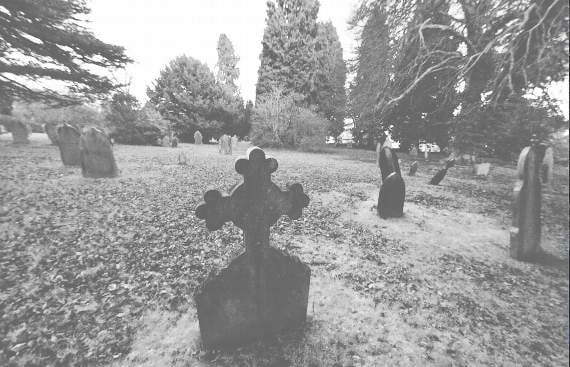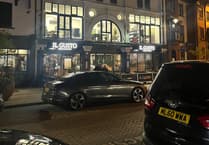FOUR years after the blood and butchery of the Jack the Ripper murders whose macabre mutilations and sickening sadism had reached a cold and vile hand out from the shadows and slums of Whitechapel to infect the national psyche as a whole, the ‘Gateway to Wales’ was rocked to the core by its very own torrid and twisted tale of prostitution and savage murder.
Chronicle reporter TIM BUTTERS lifts the lid off a little known chapter in the town’s history that plays itself out like a penny dreadful saga full of the hellish horrors of wanton bloodlust, twisted retribution, loose virtue, unmarked graves and finally - the inexorable and mocking swing of the hangman’s noose.
It was another busy Friday night in Victorian Abergavenny, the date was September 16, 1892, and the public houses were heaving with the trade of customers eager for the high spirits and blessed oblivion to be found in a pint of beer or shot of whiskey.
Yet for one reveller, this bawdy night of drunken abandon was to be her last.
Mary Conolly, a well-known alcoholic and prostitute was celebrating her release from Usk gaol after having spent the last 28 days there for being drunk and disorderly.
Mary was renowned throughout town as a ‘slave to the bottle’ and during the day she had stumbled from one public house to the other, busily slating the thirst of the demon on her shoulder whilst toasting her newly-acquired liberty.
In her rounds of such pubs as the Foresters Arms and the Cross Keys Inn she was accompanied by a strange man not familiar to the beady and enquiring eyes of the local inhabitants.
Her final port of call and last shot of liqueur before she was ripped bloodied and screaming from this mortal coil was in the snug confines of the town’s Somerset Arms in Merthyr Road.
At 7.30pm that evening Mary and her companion entered the pub where she ordered a whiskey for herself and a beer for the mysterious man.
Less than an hour later Mary’s throat was cut from ear to ear with such animalistic savagery that her head was almost decapitated.
Covered in blood and in what must have been unbearable agony, she dragged herself 200 yards from the spot where her attacker had left her for dead, in a desperate bid for help before the life seeped out of her completely.
Unfortunately, her wounds were far too severe and Mary, lying prostrate and pale in a pool of her own blood, was found in the gutter only a short time later by railway-man Edward Wilkins
The poor doomed daughter of Jeremiah Conolly and a long time resident of Pant Lane would never again bear witness to the rising of a sun or the falling of a star.
Her eyes were unseeing, her heart had been stilled and her final horrors had been rendered mute for all time.
She was tragically dead, butchered by the murderous whim of a madman’s hand at the age of just 22.
An Abergavenny Chronicle report from September 23, 1892 states, ‘The scene of the murder was on one of the allotments abutting upon the newly made Hatherleigh Road and leading from Brecon Road near Hatherleigh Lodge to the Union Lane a few yards below the workhouse garden.’
The report goes on to read ‘A guard employed by the railway company was proceeding to work along Hatherleigh Road when his attention was attracted by smothered choking sounds and having struck a match he looked around and discovered what he first thought to be a heap of clothes in the gutter.
On closer examination he found it to be a woman with her face covered in blood and her dress saturated in blood, which had flowed from a deep gash in her throat.’
Wilkins ran off to inform the police immediately and word soon spread like wildfire through what was then known as the ‘Irish part’ of town where Mary had lived.
The ‘Irish Part’ of town, so called because of the number of Irish immigrants residing there, once encompassed the whole of the Tudor and Castle Street areas with its characteristic sprawl of medieval and Elizabethan dwellings, narrow, winding streets, numerous pubs and well known brothels.
This was of course long prior to the ‘slum clearance’ schemes of the 1950s and 60s, which many felt ripped a lot of the heart and soul out of ‘old mother Aber’.
The murder scene was visited by the county police surgeon Dr. Elmer Steele before Mary’s corpse was removed to the Workhouse mortuary, where Steele ascertained the cause of death as a massive wound which had severed the windpipe.
Superintendent Freeman who also attended the scene of death said at the inquest, “I saw her (Mary) in the position in which she was found. She was on her back, face upwards, she was in the gutter lengthwise, her head towards Brecon Road and her feet toward the Union.”
The Chronicle reported, ‘A minute description of the man who was seen in the girl’s company was given and great anxiety was manifested throughout the town that the culprit should not escape.’
The town needn’t have worried because to everyone’s shock, a little over a day later, a 30-year-man living in Lower Hill-Street, Blaenavon who went by the name of Thomas Edwards walked into the police station in the early hours of Sunday morning and confessed to Mary’s murder.
Edwards, a former soldier who had previously served in the 53rd Shropshire Regiment, was said to exhibit little concern regarding his position and showed no remorse or regret.
He was described as a man of slight build with a somewhat vacant expression.
In an voice devoid of all emotion Edwards told the court during his one-day-trial, “She (Mary) asked me to go along with her and she took me into some garden or field.
“She laid down and I cut her throat with a razor. I knew her before about two months ago and she took my two pound off me and she had also given me the ‘bad disorder’.”
Quite shockingly a cold-blooded Edwards went onto reveal, “I left her on the ground and came back to the same public house (Somerset Arms) at which I had a glass of beer.”
Edwards’s Blaenavon landlady Mrs Morgan later explained to a reporter from the Western Mail that Edwards would often go to Abergavenny by train, for the purpose, so he made out, of seeing a sister.
On one occasion he stayed four or five days and when he returned was without any money, suggesting that Edwards had more of a relationship with Mary, or at least other women of ‘ill repute’, than he later cared to admit.
Edwards’s defence pleaded that the accused was of not sound mind and that his mother had been confined to Abergavenny’s Pen-y-Fal Asylum for the last 20 years.
It was further revealed that his uncle was known as a ‘complete imbecile’ and his grandfather went by the name of ‘silly Davis’.
In his only explanation of why he took such a young life and cruelly cut it short, Edwards said, “I think it is about six or seven years since Colonel Findall commanding the Shropshire Regiment was murdered in Birmingham by one of these loose girls. Since then my mind has always been against them.
“If I had a good chance I should have killed one before, and intended going to Newport and killing one or two there, only I had no money.
“I served in the Egyptian campaign and got invalided from there with a very bad fever and suffered from pains in my head and I had suffered from the pains before committing the deed.”
The jury didn’t hesitate in passing a verdict of guilty and in passing sentence the Judge told Edwards, “I can only pray you take earnest advantage of the time you have yet to spare here. Short as it may be, it is abundantly sufficient to prepare yourself for the meeting of your God.”
Said to be apparently unconcerned to his impending fate’, by all those who visited him in Usk Prison, Edwards kept his appointment with the hangman’s noose on December 27, 1892, at 8am.
Minutes later a black flag wIth the word ‘JUSTICE’ emblazoned upon it in bold white capitals was hoisted high above the prison walls.
The assembled crowd greeted the sight of the flag with cheers as it flew fiercely indifferent and eternally elusive in the grey early morning skies.
Yet for poor Mary even death could not free her from further indignity.
As a Roman Catholic, the church to which she belonged deemed her as a ‘notorious public sinner’ and refused her the usual Catholic rights of burial on the grounds that she had not been reconciled with her maker before death.
As such there was no burial service for Mary, who was finally laid to rest in an unmarked common grave, as a handful of her relatives and friends offered up silent prayers to a distant and authoritarian God in the hope of some sort of salvation for the girl they had once known and loved.•This article was first published in The Abergavenny Chronicle in February 2011.





Comments
This article has no comments yet. Be the first to leave a comment.